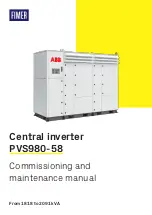
7.1 Maintenance batteries
• Performing preventive maintenance on batteries is easy and should occur at least once a month during hot weather and
every three months in cold weather. In the case of lead acid batteries the maintenance should include check the
electrolyte level for non-sealed wet batteries and the State of Charge (SOC) with hydroscope measurement of specific
gravity of the electrolyte and recharging the battery if necessary.
•
A clean well kept battery will extend the useful life of the battery. Remove dirt and dust accumulations from the top of the battery. Wash the top of the battery with clean hot water
and soda solution to neutralize any acid accumulation. Baking soda used in the home is satisfactory. Rinse with clean water and dry. Ensure vent caps are in place and no soda
enters the battery.
•
In the case of regular or low maintenance batteries: Check the height of the electrolyte twice a month. If necessary replace with approved water only - use of non-distilled water can
cause mineral build-up in the battery cell.
NEVER
fill batteries with seawater, as
DANGERUS CHLORINE GAS
will be liberated.
Never fill
the cells above the bottom of the vent well (approximately 1 inch or 25mm) below the top of the vent opening). Over filling will cause loss of electrolyte and reduce the battery
capacity. Preventive maintenance involves as a minimum to check the cell electrolyte level for correct acid volume once a month and equalizing once every six months.
• In the case of sealed battery the state of charge can be practically evaluated by measuring open cell voltage, with a
digital multi-meter. This method is however not 100% reliable, because sulfating of the battery may result the increased
voltage on the terminal and not fully charged battery should be considered for fully charged. Before reading out the open
cell voltage, the surface charge has to be removed – the recommended method is to allow to sir ( or rest ) the battery
without charging or discharging for between six to twelve hours at room temperature if possible.
• As a part of the maintenance always tight loose hold-down clamps to prevent excessive vibration, battery lugs, terminals
and connectors.
Clean the battery top to eliminate conductive paths created by dried or wet electrolyte and prevent corrosion.
• Secure the batteries always are fully charged.
• Batteries must not be left discharged for longer period without charging.
• Recharging on regular basis tends to prevent irreversible permanent sulfating
• Open / Wet batteries need topping up with distilled water frequently.
• Use protective goggles and rubber gloves, when working with batteries (acid)
• Clean battery top and poles.
• Use anti corrosion oil or Vaseline on pole bolts to preserve the surface.
• Remove any corrosion, lead oxidation, paint or rust with a battery brass wire brush
• Don’t place the batteries in hot areas.
• Check min once a year the pole bolts are well tightened.
• Replace the battery if the battery case is bulging, cracked or leaking.
7.2 Battery storage
• Lead-acid batteries must be stored in the open-circuit condition with the terminals insulated. Long periods of storage at
even low drain rates may result in permanent damage. Batteries should be stored in cool, dry, environments in their
upright position.
• Batteries that will be stored for extended periods should undergo regular open-cell voltage checks and be recharged as
necessary – this recharging will also prevent the build up of the damaging process of sulfating of the battery.
Continuous
float charging or periodic recharging will prevent batteries from freezing.
•
Do not store the lead acid batteries in discharged state
•
Batteries should be kept at least 3/4 charged, especially during winter weather.



































